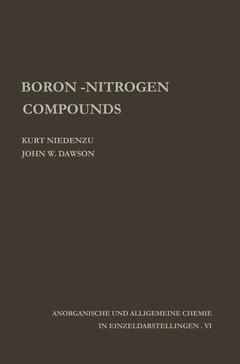Description
Boron-Nitrogen Compounds, Softcover reprint of the original 1st ed. 1965
Anorganische und allgemeine Chemie in Einzeldarstellungen Series, Vol. 6
Authors: Niedenzu Kurt, Dawson J.W.
Language: English
Subject for Boron-Nitrogen Compounds:
Keywords
ALF; ALFRED; Chemical reaction; Diboran; Hydrazin; Nitrogen; boron; chemistry; experiment; information; molecule; reactions; structure
Approximative price 84.35 €
Subject to availability at the publisher.
Add to cart
Boron-Nitrogen Compounds
Publication date: 01-1965
Publication date: 01-1965
Boron-Nitrogen Compounds
Publication date: 04-2012
176 p. · 15.5x23.5 cm · Paperback
Publication date: 04-2012
176 p. · 15.5x23.5 cm · Paperback
Description
/li>Contents
/li>
Although the chemistry of boron is still relatively young, it is developing at a pace where even specific areas of research are difficult to compile into a monograph. Besides the boron hydrides, boron-nitrogen compounds are among the most fascinating derivatives of boron. Nitrogen compounds exist in a wide variety of molecular structures and display many interesting properties. The combination of nitrogen and boron, however, has some unusual features that are hard to match in any other combination of elements. This situation was first recognized by ALFRED STOCK and it seems proper to pay tribute to his outstanding work in the area of boron chemistry. One should realize that about forty years ago, STOCK and his coworkers had to develop completely new experimental techniq'\les and that no guidance for the interpreta tion of their rather unusual data had been advanced by theoretical chemists. In this monograph an attempt has been made to explore the general characteristics of structure and the principles involved in the preparation and reactions of boron-nitroge~ compounds. It was a somewhat difficult task to select that information which appears to be of the most interest to "inorganic and general chemistry" since the electronic relationship between a boron-nitrogen and a carbon-carbon grouping is reflected in the "organic" character of many of the reactions and compounds.
Nomenclature of Boron-Nitrogen Compounds.- I: Amine-Boranes and Related Structures.- A. The Boron-Nitrogen Dative Bond.- B. Amine-Boranes Derived from BH3?nR n.- C The Chemistry of the Diammoniate of Diborane and Related Structures.- D. Adducts of Trihalogenoboranes with Nitrogen Donor Molecules.- E. Amine Adducts of -Oxyboranes, Boroxazolidines and Ring Systems with the Annular N?B Bond.- II: Aminoboranes, ?N—B?.- A. The Nature of the B—N Bond in Aminoboranes.- B. Monoaminoboranes.- C. Trimeric Aminoboranes.- D. Bisaminoboranes.- E. Trisaminoboranes.- P. Diborylamines.- G. Hydrazino- and Azido-Boranes.- H. Amino Derivatives of Diborane(4).- III: The Borazines.- A. Introduction.- B. The Parent Borazine, (—BH—NH—)3.- C. Symmetrically Substituted Borazines, (—BR—NR’—)3.- D. Unsymmetrically Substituted Borazines.- E. Polynucleated Borazines.- IV: ?-Bonded Cyclic Systems of Boron and Nitrogen (other than borazines).- A. General Remarks.- B. s-Diaza-Diborines.- C. 1,3,4-Triaza-2,5-Diborines.- D. 1,2,4,5-Tetraza-3,6-Diborines.- E. s-Tetraza-Tetraborines.- V: Heterocyclic ?-Bonded Systems Containing Boron and Nitrogen.- A. Introductory.- B. Heterocycles with Aminoborane Linkages.- C. 1,3,2-Benzodiazaborolidines and Related Compounds.- D. Heteroaromatic Boron-Mtrogen Compounds.- VI: Boron Nitride.- A. Preparation and Structure.- B. The Nature of the Coplanar B—N Bond in Hexagonal Boron Nitride.- C. Physical Properties of Hexagonal Boron Nitride.- D. Chemical Reactions of Boron Nitride.- A. General Remarks.- Author Index.- Table Index.
© 2024 LAVOISIER S.A.S.
These books may interest you

Boron Reagents in Synthesis 232.03 €



